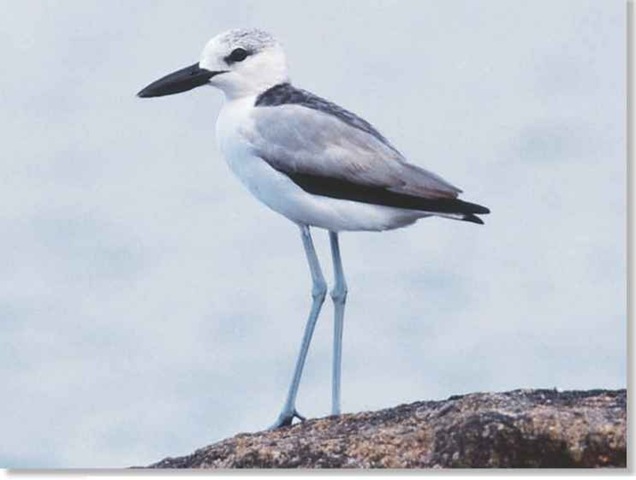ORDER
Charadriiform.es
FAMILY
Dromadidae
GENUS & SPECIES
KEY FEATURES
• The only wading bird in the world to breed underground in self-excavated burrows
• The only member of its family; differs from other plovers in appearance and breeding
• Dependence on crabs as its main food choice restricts the plover’s range
WHERE IN THE WORLD!
Found along the west Indian Ocean coastline, from Madagascar and Africa east to Pakistan and India; also in Thailand and Malaysia
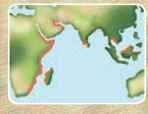
Lifecycle
A born beachcomber, the crab plover thrives at the seashore, probing for crabs and other crustaceans and scooping out a nesting tunnel in the sand dunes.
HABITAT
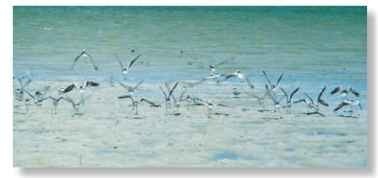
A Change of address A flock of crab plovers prepares to migrate to wintering grounds
True to its name, the crab plover favors coastal areas and islands where there are an abundance of crabs. Found mainly along the east African
coast, Madagascar and other Indian Ocean islands, the crab plover also migrates to various beaches along the coasts of India and Sri Lanka. The crab plover’s breeding range is very restricted. The sites are found exclusively on the Indian coastline of the Persian Gulf and Arabian peninsula and islets off North Somalia. Traveling inland less than 1 mile, the crab plover searches for sand that is soft enough to shovel, but moist enough to hold together when the crab plover burrows its nesting tunnel. In addition, there must be plenty of crabs nearby. Only a dozen or so crab plover breeding locations are known, and several have been abandoned in recent years.
# The crab plover’s breeding cycle is synchronized so that the chicks hatch when crab numbers are at their peak.
The crab plover nests underground, so its egg needs no camouflage.
Researchers believe that the crab plover, the only member of the family Dromadidae, has been on an evolutionary monorail for 35 million years — it has changed very little over the ages.
BREEDING
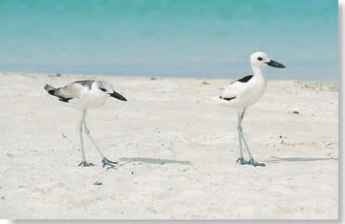
The crab plover digs deep nests to safeguard its young. A mating pair tunnels into sand dunes, burrowing up to 6.5′. The tunnel slopes downward before it rises upward to an unlined nesting chamber, which protects the egg and chick from predators and the hot sun. A group of up to 10 non-breeding plovers help attend the nest, assisting the male in bringing food to the incubating female and the newborn chick. This communal breeding is rare among wading birds. The chick remains with its parents for several additional months, during which time it can often be heard begging with a whistling call.
FOOD & FEEDING
The crab plover feeds during the day, always poking and prodding beach sand in search of crabs. In groups of up to 1,000 birds, the crab plover easily wades with its long legs along tidal areas. Standing about 1 5′ apart, the birds scan the sand carefully with their large eyes wide open, looking for telltale marks of burrowing by crabs, marine worms, mollusks and other invertebrates. The plover spots the mark or movement where its prey is buried and then races toward its target.
Crab plovers also venture into mangroves to scoop up the crabs that have emerged from their burrows to scuttle over the surface. Before the crab even has a chance to strike, the crab plover effortlessly breaks the animal’s shell in its powerful bill and devours the meat inside. During the breeding season, the crab plover uses its bill to make a crab pulp for its chick, until the juvenile is old enought to join its parents in the search for crabs.
Wading along The crab plover searches for crabs year-round
UNDERGROUND NURSERY
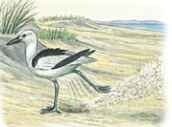
1 Labor of love…
Unlike other wading birds, the crab plover tunnels through the moist sand and makes a nest inside a dune.
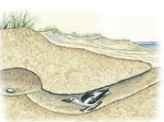
2 Fits like a glove…
The 6.5′-long tunnel leads to the darkness of the nesting chamber where the plover lays only a single egg.
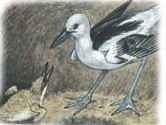
3 Dinner bell…
The young chick begs for food at the tunnel entrance with a whistling call. The parent makes a pulp from its crab meal to feed the chick.
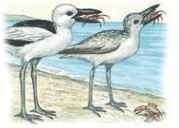
4 Show and tell
The juvenile, still semi-dependent on its parents, receives a lesson on breaking crabs. It stays with its parents for several months.
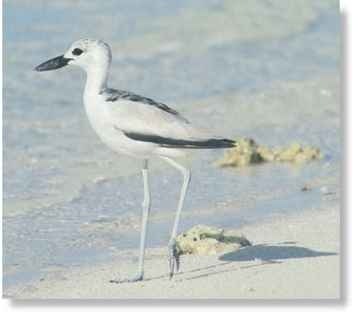
BEHAVIOR
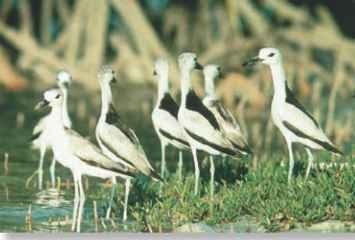
A Crab grab A group of hungry plovers pokes around mangroves, constantly searching for scurrying crabs.
Sociable crab plovers flock together while feeding and nesting. The long-legged birds wade in shallow water on the lookout for a meal, then fly to nearby sand dunes to build deep nesting chambers. The sandbanks often look like large honeycombs with their hundreds of tunnel openings. In low flight between feeding areas, the birds are easy to identify:they fly in tight formation, with their legs trailing behind them and their necks extended. But the crab plover can also be heard. A loud shrill call carries up to I mile away, and a constant barking call, crow-ow-ow, carries almost as far
The majority of crab plovers migrate from their breeding grounds to overwinter in southern locations with a fresh supply of crabs. Flying high, the adults and juveniles keep in straight-line orV formations, with their necks retracted for streamlining. The young can often be heard throughout the winter uttering a high whistle, begging for food. Though capable of flight, the young remain semi-dependent on their parents for food for several months.
CONSERVATION
Despite its restricted breeding and wintering grounds, crab plover populations seem healthy. The largest population in the non-breeding range is in Tanzania, where about 26,000 birds migrate for the winter. The bird’s limited range and limited diet could prove a problem for the crab plover in the future.
Profile
Crab Plover
The unique crab plover is a standout on the shore; its large, powerful bill and long legs make it an accomplished shellfish hunter.
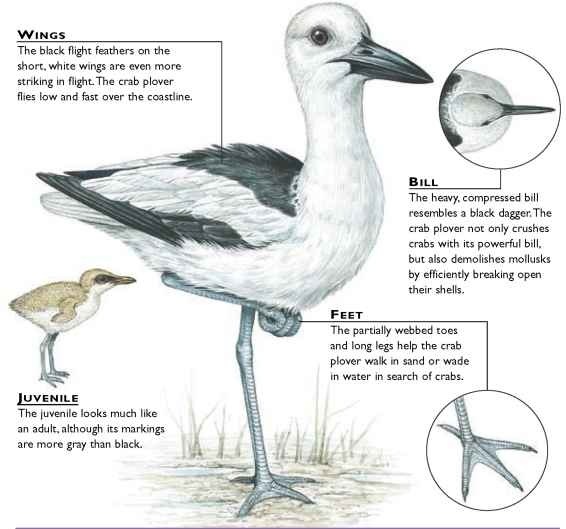
CREATURE COMPARISONS
Measuring I 8-19.5″, the Australian
pied oystercatcher (Haematopus longirostris) is slightly larger than the crab ploverThe oystercatcher’s black head and neck contrast sharply with the crab plover’s white neck and head. Easily recognizable with its orange bill and legs, the oystercatcher pokes and pries open oysters and other shellfish with its long, knifelike bill. Both birds flock to sandy beaches, but the crab plover builds an elaborate nest, while the pied oystercatcher makes no nest at all.
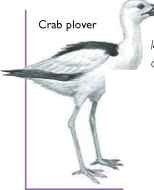
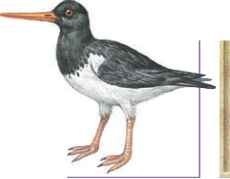
Australian pied oystercatcher
| VITAL STATISTICS | |
| Weight | 11.5 oz. |
| Length | 15-16″ |
| Sexual Maturity | Unknown |
| Breeding Season | May and June |
| Number f. of Eggs | 1 |
| Incubation Period | Unknown |
| Fledging Period | Unknown |
| Breeding | Interval | 1 year |
| Typical [diet | Mainly crabs, but also other crustaceans, mollusks, marine worms and other invertebrates |
| Lifespan | Unknown |
RELATED SPECIES
• The crab plover is the only member of the family Dromadidae. Its unique physical appearance and breeding behavior exclude it from the plover family, Charadriidae. The approximately 60 species of plover in this family have short legs and bills. The thick knees, in the family Burhinidae, include the water dikkop, Burhinus vermiculatus, which more closely resembles the crab plover.
